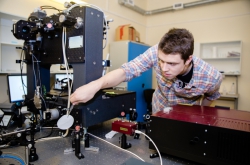Optical links have a high bandwidth and can transfer huge amounts of data at a high speed. That's why research teams around the world have been working on research into an optical computer on a chip, which could perform all data operations exclusively at the expense of potential photonic and optical technologies.
However, in order to control the light at nanoscale, ordinary light can not be used — it has too large a wavelength. This is why surface waves need to be used, the study of which (in particular, plasmon-polariton surface waves on the metal-dielectric boundary) is being done currently by various research teams. For signal transmission by means of such waves, one must learn how to effectively manage their distribution. In particular this can be done using devices called demultiplexers, which make it possible to spatially separate surface waves at different frequencies. The more sensitive the device will be to changes in the wavelength, the more signals, whose frequency lies in the operating frequency range, it will be able to process simultaneously, which determines the speed of optical signal processing. Another important condition: in order to become the basic element of devices for optical information processing on a chip in the future, in contrast to existing demultiplexers with surface waves of a size more than 5 by 5 microns, the new demultiplexer should be much smaller.
Such a compact device based on dielectric particles was proposed by a group of scientists from ITMO University. The researchers of the laboratory "Metamaterials" have, for the first time, theoretically predicted and experimentally demonstrated a method to effectively control the propagation of surface waves using a dielectric nanoantenna diameter of less than 150 nm.
“We have been researching such particles a lot and for a long time in our laboratory. One of their remarkable properties is that they have a magnetic response to optical frequencies, which is quite unusual. Such a magnetic response has been applied before in specific cases, but this particular device can be used for directional launching of surface waves, which no one had come up with before us. We wrote a very simple theoretical model and conducted an experiment. And, to our surprise, this basic theoretical model matched perfectly our experimental results. Thus, we demonstrated for the first time that it’s possible, by directing light on one small particle with a diameter of 150 nanometers, to effectively launch surface plasmons (represent resonant oscillations of the electrons in the surface layer of metals under an external electric field - ed.) and divide them into wavelengths. It was also possible to divide the plasmons, the wavelengths of which differ by 10 nanometers, while during the experiment it seemed that the sensitivity is higher than predicted by theory.” commented Ivan Iorsh, one of the authors of the article, researcher at the Department of Nanophotonics and Metamaterials at ITMO University.
The researchers note that the developed method will make it possible in the future to abandon the use of large devices and to separate the surface waves of different frequency, by using dielectric particles with properly chosen parameters. Compared to other promising devices that can be created this way, this one is more compact, but at the same time preserving high efficiency. The fabrication method is inexpensive – however, now scientists have to figure out how to produce them at an industrial scale. In addition, in the future the research group plans to continue to experiment with the geometry of the particles. This may allow them to significantly improve the sensitivity of devices — from 10 nanometers to one.
Article: Ivan S. Sinev, Andrey A. Bogdanov, Filipp E. Komissarenko, Kristina S. Frizyuk, Mihail I. Petrov, Ivan S. Mukhin, Sergey V. Makarov, Anton K. Samusev, Andrei V. Lavrinenko,Ivan V. Iorsh,Chirality Driven by Magnetic Dipole Response for Demultiplexing of Surface Waves, Laser & Photonics Reviews, 2017






